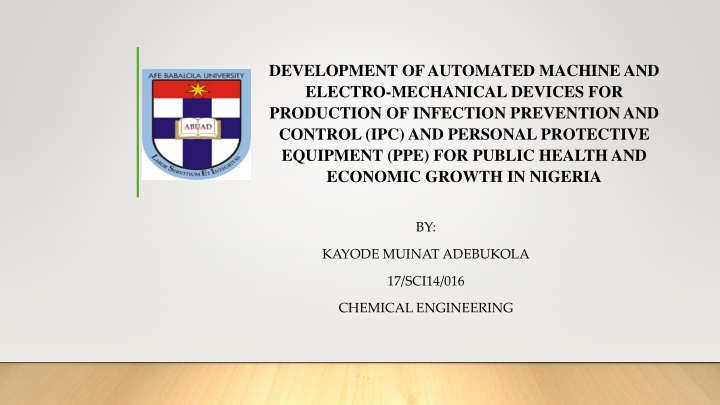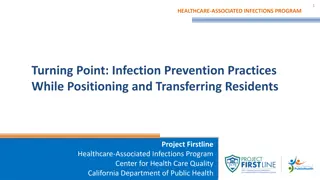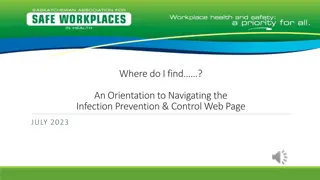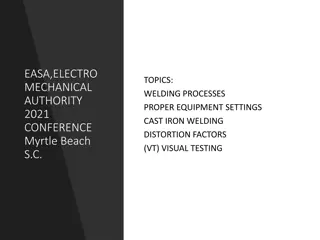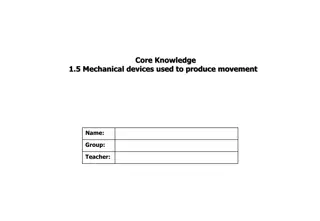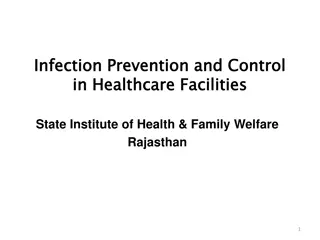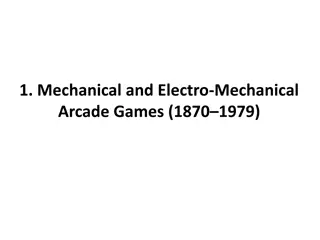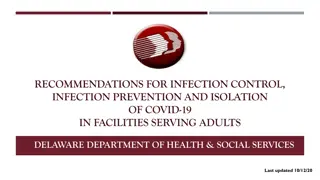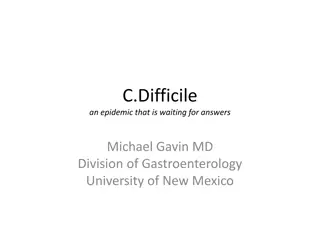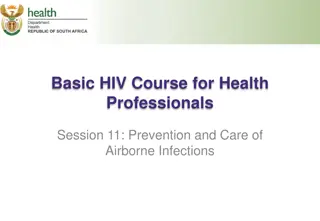Automated Machine & Electro-Mechanical Devices for Infection Prevention & Control
Technology aiding in the production of infection prevention measures & personal protective equipment for public health & economic growth in Nigeria by Kayode Muinat AdeBukola
Download Presentation

Please find below an Image/Link to download the presentation.
The content on the website is provided AS IS for your information and personal use only. It may not be sold, licensed, or shared on other websites without obtaining consent from the author.If you encounter any issues during the download, it is possible that the publisher has removed the file from their server.
You are allowed to download the files provided on this website for personal or commercial use, subject to the condition that they are used lawfully. All files are the property of their respective owners.
The content on the website is provided AS IS for your information and personal use only. It may not be sold, licensed, or shared on other websites without obtaining consent from the author.
E N D
Presentation Transcript
DEVELOPMENT OF AUTOMATED MACHINE AND ELECTRO-MECHANICAL DEVICES FOR PRODUCTION OF INFECTION PREVENTION AND CONTROL (IPC) AND PERSONAL PROTECTIVE EQUIPMENT (PPE) FOR PUBLIC HEALTH AND ECONOMIC GROWTH IN NIGERIA BY: KAYODE MUINAT ADEBUKOLA 17/SCI14/016 CHEMICAL ENGINEERING
WHAT IS AUTOMATION? Automation is the technology by which a process or procedure is performed with minimal human assistance. Automation or automatic control is the use of various control systems for operating equipment such as machinery, processes in factories, boilers and heat-treating ovens, switching on telephone networks, steering and stabilization of ships, aircraft and other applications and vehicles with minimal or reduced human intervention. Automation covers applications ranging from a household thermostat controlling a boiler, to a large industrial control system with tens of thousands of input measurements and output control signals. In control complexity, it can range from simple on-off control to multi-variable high-level algorithms.
WHAT ARE ELECTRO-MECHANICAL DEVICES? Electromechanical devices are ones which have both electrical and mechanical processes. Strictly speaking, a manually operated switch is an electromechanical component due to the mechanical movement causing an electrical output. Though this is true, the term is usually understood to refer to devices which involve an electrical signal to create mechanical movement, or vice versa mechanical movement to create an electric signal. Often involving electromagnetic principles such as in relays, which allow a voltage or current to control another, usually isolated circuit voltage or current by mechanically switching sets of contacts, and solenoids, by which a voltage can actuate a moving linkage as in solenoid valves.
Infection Prevention and Control (IPC) Infection Prevention and Control is a scientific approach and practical solution to prevent harm (caused by infections) to patients and health workers. Its foundation cuts across the fields of infectious diseases, epidemiology, social science and health system strengthening. IPC occupies a unique position in the field of patient safety and quality universal health coverage as it is crucial for both health workers and patients at every single health-care encounter. The basis of IPC is the identification and prioritization of infection risks followed by the application of resources to minimize, monitor, and control the problem
Standard Precautionsare the minimum level of IPC precautions based on risk assessment of a procedure or procedures, for the care and protection of patients and healthcare workers. It is applied to any patient regardless of their diagnosis or presumed infectious state. The goal is to reduce the risk of transmission of microbes from both recognized and unrecognized sources of infection and standard precautions should become second nature as part of healthcare practice. The core components of standard precautions are: Hand hygiene Safe injection practices Respiratory hygiene/Cough Etiquette Appropriate Personal Protective Equipment (PPE) Safe sharps and waste disposal Environmental disinfection and sterilization of patient s equipment Safe handling of linen Patient placement When standard precautions are correctly implemented, the spread of infectious diseases such as the VHFs Ebola and Lassa fever can be prevented or at least decreased. Below are some recommendations of how to implement standard precautions.
Standard Precautions for the Care of All Patients in All Healthcare Settings Hand hygiene: The 5 Moments for Hand Hygiene (described in more detail below in this guideline) should be observed at all the indicated moments. Before touching a patient Before performing clean/aseptic procedures After body fluid exposure risk (e.g. after handling any potentially contaminated equipment or material such as laundry, wastes, dishes, vomit and stool buckets, etc.) After touching a patient After touching patient s surroundings
Personal protective equipment (PPE) Personal protective equipment (PPE) refers to a range of barriers and respirators used alone or in combination to protect mucous membranes, airways, skin, and clothing from contact with infectious agents. The selection of protective equipment required depends on an assessment of the risk of transmission of microorganisms to the patient, and the risk of contamination of the healthcare practitioner s clothing and skin by patients blood, body fluids, secretions or excretions. Practice staff should make a risk assessment of the planned procedure/action and select PPE, depending on: The nature of the procedure The risk of exposure to blood, body fluids, mucous membranes and non-intact skin The risk of contamination.
REMOVING PPE To reduce contamination of clothes/hands/environment: When removing gloves do so with a technique that avoids contamination of the hands and the environment. Remove until both gloves are inside out, then discard into the appropriate waste stream. The outer, contaminated side of the apron/gown is turned inward and rolled into a bundle before discarding into the appropriate waste stream. Remove mask by breaking the ties (do not touch the front of the mask). Discard all PPE into the appropriate waste stream. PPE that is blood stained or contaminated with body fluids should be placed into the healthcare risk waste stream. PPE that is not blood stained or contaminated with body fluid may be placed into the domestic/non-healthcare risk waste stream. Always perform hand hygiene after PPE is removed.
METHODOLOGY Intersecting Electrical and Mechanical Development to develop better devices As medical devices become increasingly complex in functionality, medical device companies seek reliable partners for their medical electronics projects. Hardware engineering is often required for many of the medical devices we develop for our clients. Since both are crucial to the development of a device, we have created systems to help clients during their device s development process. Expert engineers have designed electronic and electromechanical systems with performance, reliability, cost, manufacturing, and regulatory compliance in mind. A team of experienced engineers offer specialized skills and abilities for a wide range of medical device electromechanical development projects, focusing on a product scale from table top sized equipment to implantable devices.
STRATEGIC OBJECTIVES: WHO s strategic objectives for this response are to: Interrupt human-to-human transmission including reducing secondary infections among close contacts and health care workers, preventing transmission amplification events, and preventing further international spread; Identify, isolate and care for patients early, including providing optimized care for infected patients; Identify and reduce transmission from the animal source; Address crucial unknowns regarding clinical severity, extent of transmission and infection, treatment options, and accelerate the development of diagnostics, therapeutics and vaccines; Communicate critical risk and event information to all communities and counter misinformation; Minimize social and economic impact through multisectoral partnerships. *This can be achieved through a combination of public health measures, such as rapid identification, diagnosis and management of the cases, identification and follow up of the contacts, infection prevention and control in health care settings, implementation of health measures for travelers, awareness-raising in the population and risk communication
As of March 2020, there is reduced access to PPE and hand hygiene materials across the globe, therefore, rational use of PPE and hand hygiene materials for the care and management of COVID-19 is encouraged (WHO 2020). For staff this involves selecting the proper PPE and being trained in how to put on, remove and dispose of it. Optimal PPE availability can be achieved through the following steps: Minimizing the need for PPE by means of telemedicine, using physical barriers (glass or plastic windows) to reduce exposure, restricting staff s presence in the rooms of COVID-19 patients (also consider bundling activities), restricting visitors access to facilities, and providing clear instructions regarding PPE use and hand hygiene. Ensuring rational and appropriate use of PPE (staff using specific PPE for various types of care, efficient allocation of masks, coordinated PPE supply chain management mechanisms). If PPE stocks are insufficient, staff should be allocated to perform a procedure, or set of procedures in designated areas.
ANALYSIS OF RESULTS Based on the research on Infection Protection and Control (IPC), Personal protective equipment (PPE) is a critical component in the hierarchy of controls used to protect healthcare personnel from influenza and other viral respiratory diseases. Understanding the functional issues related to the design of PPE as well as the factors that impact use are critical to ensuring that healthcare personnel are adequately protected, comfortable, and able to perform their jobs. Important advances have been made in some areas since the 2008 IOM report, but other areas, particularly regarding improvements in gowns, gloves, face masks, and face shields, need to be more fully addressed. Much research has been done regarding filtration of respirator media, but ways to improve fit, including new technologies specifically for filtering facepiece respirators, need more research because face seal leakage greatly exceeds filter penetration in the overall TIL of respirators. The physiological impact of respirators has been studied in-depth, but research in this area is lacking for other types of PPE. Integration issues concerning PPE and medical equipment and the impact on operational performance have not been adequately studied
HOW IT AFFECTS ECONOMIC GROWTH Engineers have historically played a very important role in the process of global economic development and public health. The improvement of infrastructure often acts as a catalyst for reducing the significance of factors inhibiting development, such as the spread of waterborne and other contagious diseases. At the same time, it strengthens the impact of those factors that can speed up the development process, such as improved transport links that in turn contribute to growth in trade, enhance the prospects for access to schooling and encourage labour mobility. Investment in communications networks, enabling access to information, the internet and mobile telephony also plays a key role in economic development and growth.
BENEFITS IN PUBLIC HEALTH 6 benefits that can be realized by applying automation to healthcare: 1. Labor Savings Using automation to replace manually intensive tasks that are better done by machine can be a big time saver. It doesn t have to eliminate employees, but rather elevate them into higher-functioning roles that make use of the clinical expertise they have been trained for. 2. Improved Quality and Consistency Automation tools are not subject to human error or fatigue, so they can help provide a consistent basis of care activities. A Texas hospital study found that greater automation in the areas of medical records, order entry, and decision support appeared to result in a reduction in deaths, complications and cost. 3. Reduced Waste Use of paper and spreadsheets and other workarounds needed for an overfull workload can lead to a lot of waste. For example, rather than playing phone tag with a discharged patient in the free minutes between hospital nursing duties, automation can help get nurses and patients connected more efficiently.
4. Increased Predictability of Outcomes When patients follow a standardized care path supported by automation, it is more likely they will stay on track towards predicted outcomes. Additionally, automation can help detect when a patient has deviated from the recommended care plan so the care team can intervene. 5. Higher Throughput A nurse supported by automation tools can handle a larger population of patients at one time. Instead of scaling up and down your headcount as patient volumes grow and shrink, an automated platform can scale flexibly to address groups of all sizes. 6. Data-Driven Insights Technology used to automate processes can also deliver a wealth of data in a continuous feedback loop that can be used for performance improvement and optimization. With every cycle, automation systems can collect data on how the process is working and use that information to improve the program. This way it improves on itself over time, becoming even more efficient, more accurate and more helpful to the team s workload.
CONCLUSION In summary, Automated machines and Electro-mechanical devices play major roles in the development of PPE which plays an important role in preventing pathogen transmission in healthcare settings, but its optimal design and use need to be informed by dedicated research to achieve the reliability and effectiveness needed to protect patients and HCP. Current Prevention Epicenters projects on PPE explore improvements in the use and refinements in the design of PPE and foster innovation and research to reduce the risk of transmission of infectious diseases between HCP and patients
